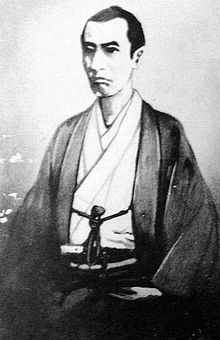Shishi (activists)
The Shishi ( Japanese 志士 ) were political activists during the late Edo period , more precisely the Bakumatsu (1853–1867). The term comes from the analects of Confucius with the meaning "strong-willed man / strong-willed men".
Shishi were usually young samurai of low rank, which meant fewer duties and more freedoms, as their everyday lives were not filled with rituals and official duties. Limited opportunities for advancement encouraged a critical mind in them. Having little information on the background of diplomacy and politics, they tended to simplify the solutions to Japan's problems, and the expectation of an approaching war with the western powers led to a flourishing of the martial arts.
They came mainly from the southwest of Japan, the daimyats Satsuma , Chōshū , Tosa and Saga .
The Shishi were not a homogeneous group, but were very different in motivation and views and were often at odds with one another.
What they have in common, however, is that they perceived the forced opening of Japan as a humiliation and demanded that the shogunate hand over all power to the emperor . It was they who emphasized the battle cry Sonnō jōi ("Adore the emperor, drive out the barbarians"). Assassinations against foreigners and high dignitaries whom they viewed as collaborators were an important political tool used by the Shishi.
Many Shishi fell victim to Ii Naosuke's Ansei Purge . Which, also because of his signing of the Unequal Treaties , made him the target of one of their attacks . During the Meiji era , many previous shishi rose to high office as part of the Meiji oligarchy .
The teachings of Yoshida Shōin exerted a great influence on them.
Until 1945 they were glorified in Japanese historiography.
Well-known representatives
- Yoshida Shōin
- Hashimoto Sanai
- Itō Hirobumi
- Iwakura Tomomi
- Ōkubo Toshimichi
- Rai Mikasaburō
- Saigō Takamori
- Yamagata Aritomo
See also
literature
- The early nineteenth century . In: Marius B. Jansen (Ed.): The Cambridge History of early modern Japan . tape 5 .. Cambridge 1989, ISBN 0-521-22356-3 (English, limited preview in Google Book Search).
- Marius B. Jansen: The Making of Modern Japan . London 2000, ISBN 0-674-00334-9 .
- Jean-Pierre Lehmann: The Roots of modern Japan . London 1982, ISBN 0-333-26604-8 .
- Conrad Totman: The Collapse of Tokugawa Bakufu 1862-1868 . Honolulu 1980, ISBN 0-8248-0614-X .
Individual evidence
- ^ Jansen, Marius B. The Making of Modern Japan. London 2000. page 327.
- ^ Lehmann, Jean-Pierre: The Roots of modern Japan. London 1982. pp. 146, 151.
- ^ Jansen, Marius B. (ed.): The Cambridge History of early modern Japan. The early nineteenth century (Volume 5). Cambridge 1989. page 365.
- ^ Jansen, Marius B. (ed.): The Cambridge History of early modern Japan. The early nineteenth century (Volume 5). Cambridge 1989. page 360.
